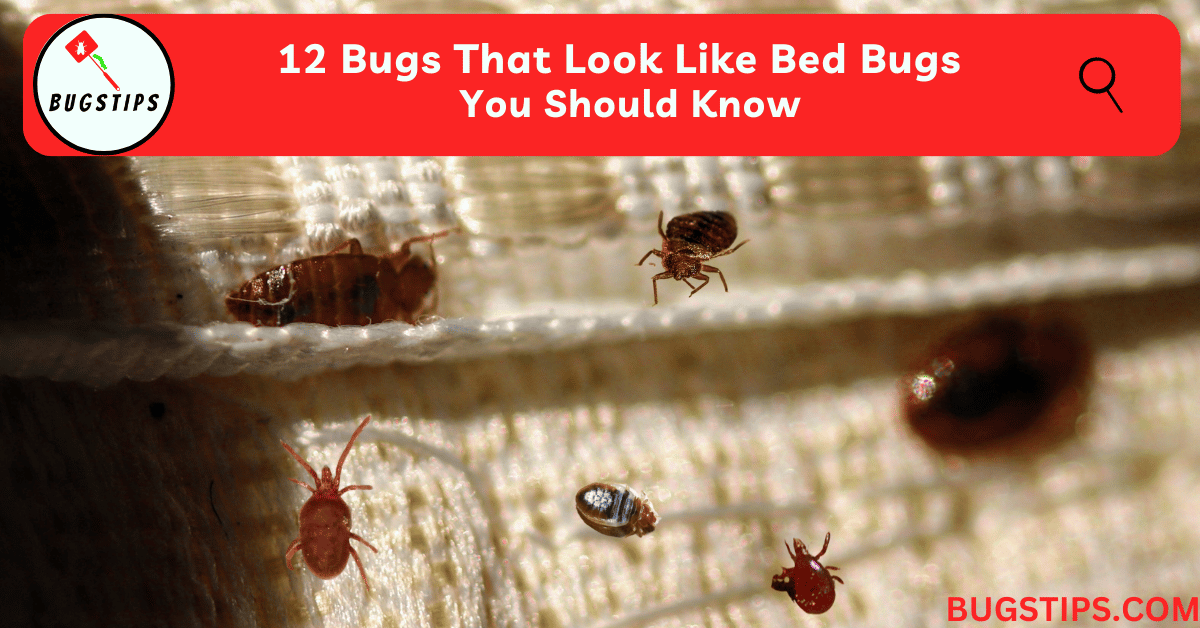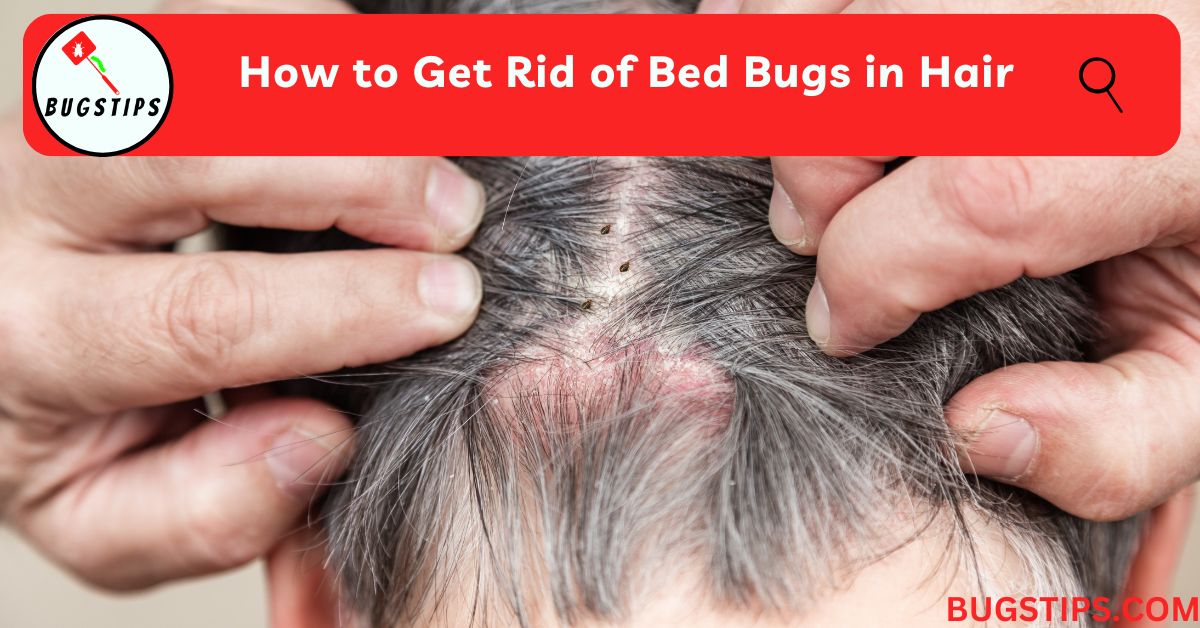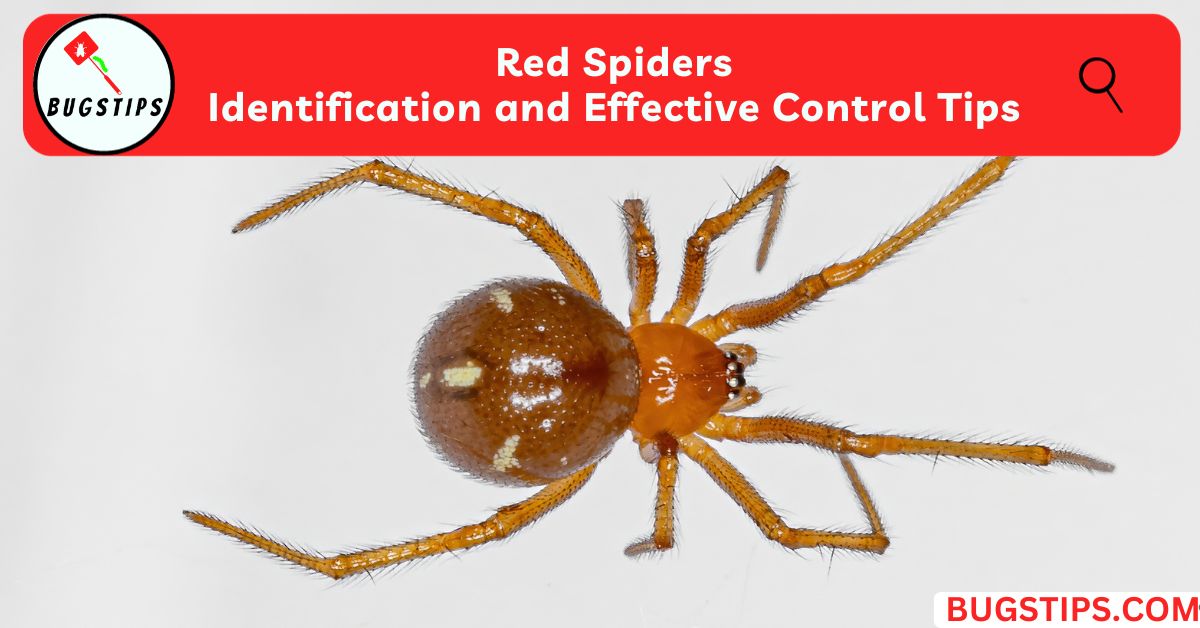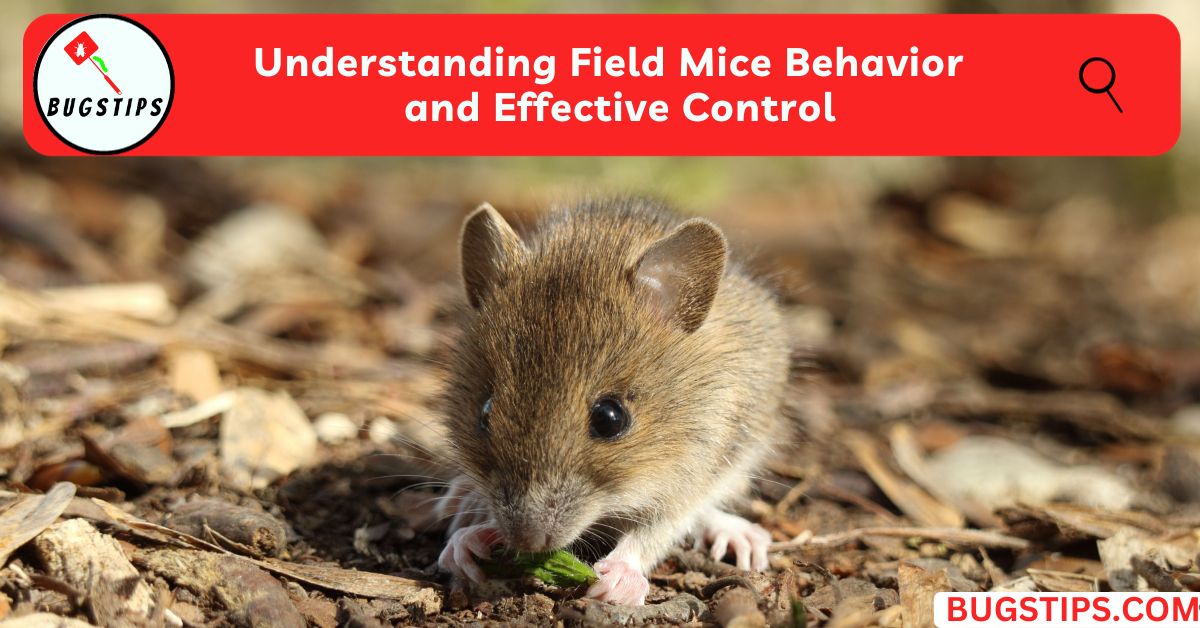This post may contain affiliate links which means as an Amazon Associate, this site may earn a small commission on qualified purchases made through links at no extra cost to you. Learn more on Affiliate Disclosure
Bed bugs are a notorious pest that can be difficult to identify and eliminate. Their small, flat, oval-shaped bodies allow them to hide in the smallest of spaces, often living right around or inside the mattress.
When bed bugs bite, they leave small, red, itchy welts on the skin. However, there are many other insects that can be mistaken for bed bugs due to their similar appearance.
In this article, we will discuss how to identify bed bugs and differentiate them from other Bugs That Look Like Bed Bugs.
We’ll explore what each of these lookalike pests looks like, what their feeding preferences are, how they differ from bed bugs in size and shape, and more.
With the right knowledge, you’ll be able to confidently determine if you really have bed bugs or if it’s another pest infesting your home.
You May Also Like – 8 Bugs That Look Like Flying Termites
What Do Bed Bugs Look Like?
Before we dive into the various bugs that resemble bed bugs, it’s helpful to understand what actual bed bugs look like. This will make it easier to differentiate between true bed bugs and imposters.
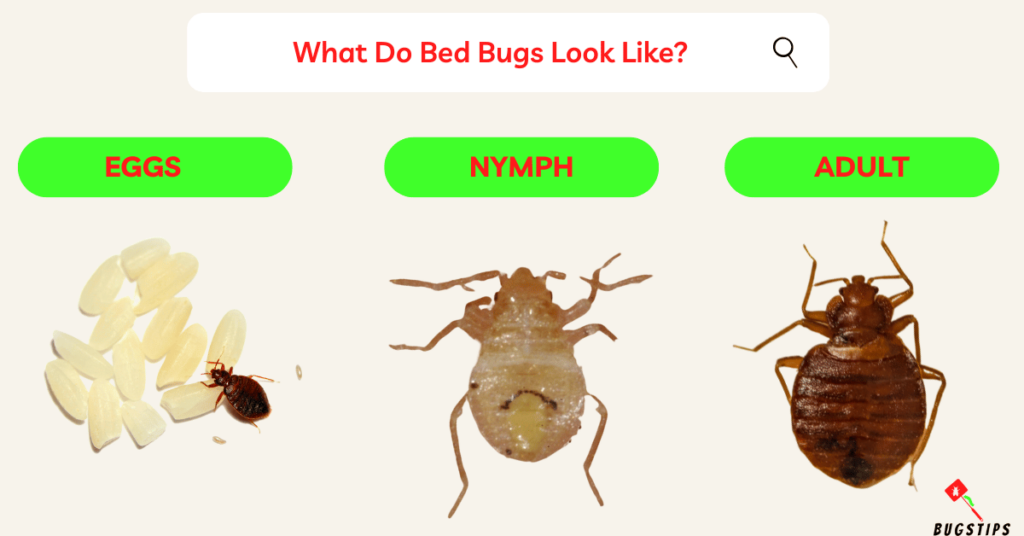
Bed bugs are small, oval-shaped, wingless insects that feed solely on blood. An adult bed bug reaches about 1/4 inch in length when fully grown.
Newly hatched bed bugs, called nymphs, are nearly colorless and look more translucent, like the shell of a seed. After feeding, both nymphs and adults take on a reddish, blood-filled tone.
Related Article – Baby Bed Bugs | 10 Facts You Need to See
The body of a bed bug is very flat, allowing it to hide in tiny crevices and cracks around the sleeping area.
The small, flat profile also lets them move stealthily between hiding spots without being detected.
Bed bugs have six legs and two antennae. Their bodies are covered in short, golden hairs.
When inspecting for bed bugs, you’ll want to look in the mattress seams, box spring, bed frame, headboard, and anywhere else they can tuck themselves away unnoticed.
Telltale signs include dark spots from blood or excrement, pale yellow shed skins, and a musty, sweet odor.
Related Article – Bed Bug Shells, Skins, and Casings
Bugs That Look Like Bed Bugs
Now that we understand the basic appearance of bed bugs, let’s explore some common insects that are often mistaken for them.
At a glance, these bugs that look like bed bugs may appear similar, but upon closer inspection there are subtle differences that set them apart.
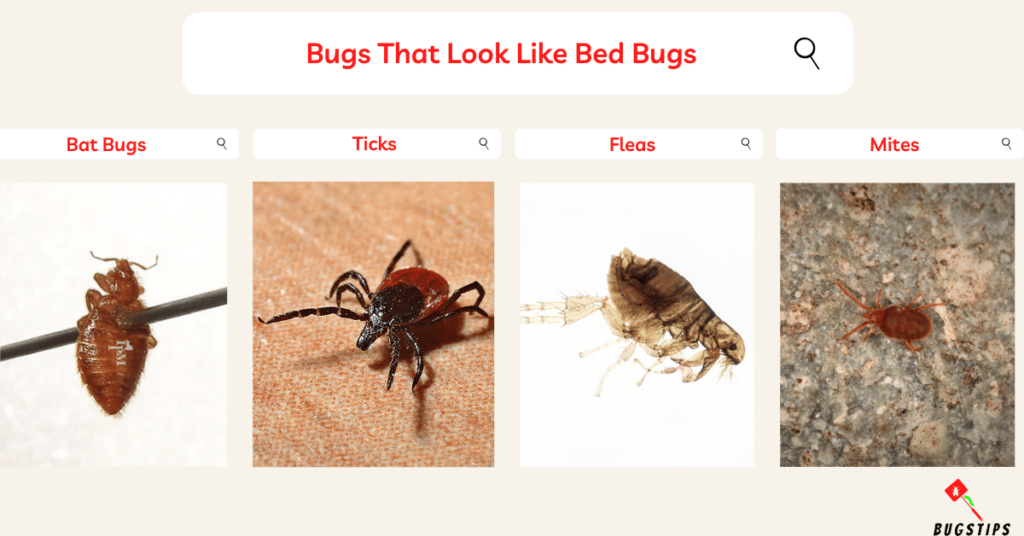
Bat Bugs
- Bat bugs are first on our list of bed bug lookalikes.
- These insects closely resemble bed bugs in both appearance and behavior.
- However, bat bugs tend to be slightly larger and hairier than bed bugs. They also give off a strong, musty odor.
- However, their preferred hosts are bats, not humans.
- They also give off a strong, musty odor.
- If you’ve had recent exposure to bats or your living space shares proximity with bat habitats their bugs could find their way inside.
Related Article – Bed Bugs vs Scabies – 5 Key Differences
Ticks
- Ticks, while distinctly different from bed bugs, can still trigger confusion due to their blood-feeding habits.
- When engorged after a blood meal, ticks can balloon up to the size of a bed bug.
- Unlike bed bugs, ticks are not primarily associated with bedding or furniture infestations.
- If you’ve spent time outdoors in areas where ticks are prevalent, it’s crucial to inspect yourself and your clothing.
You May Also Like – Do Ticks Die in the Winter?
Fleas
- Fleas are notorious for their bites and agility, which can lead to misconceptions about their identity.
- While fleas are smaller than bed bugs and have a flattened side-to-side body, their bites can cause similar itchy reactions.
- Fleas tend to infest pets and areas frequented by animals, so if you suspect fleas, ensure comprehensive pest control measures.
Related Article – What Do Fleas Look Like to the Human Eye?
Mites
- Some mites, like bird mites or rodent mites, might mistakenly find their way into homes and prompt bed bug concerns.
- However, mites are typically minuscule and difficult to see without magnification. Identifying them requires professional assistance and proper diagnostics.
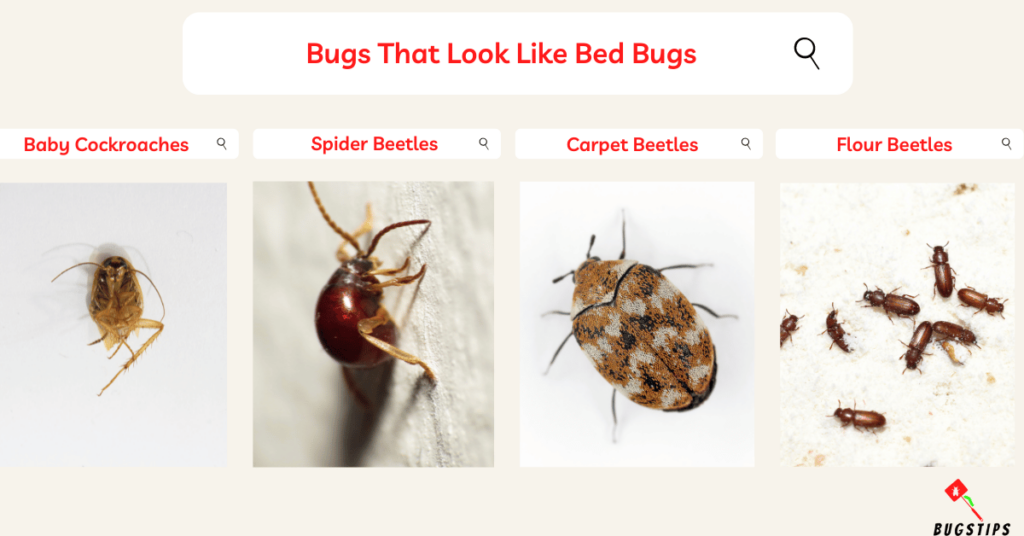
Baby Cockroaches
- While adult cockroaches don’t resemble bed bugs much, newly hatched cockroaches look similar in size, shape, and color.
- These nymphs are oval, wingless, and nearly white and they have long antennae protruding from their heads.
- However, baby roaches move quickly when disturbed, unlike bed bugs.
- As they mature, cockroaches develop a more elongated body and hard outer shell.
Related Article – 14 Small Tiny Brown Bugs In House
Spider Beetles
- Small, brown spider beetles are another insect often confused with bed bugs.
- Their oval bodies are comparable in size, but spider beetles are slightly rounder and more convex in shape when viewed from the side.
- Spider beetles can be identified by their six spindly legs and two distinctive antennae.
- They scavenge on a wide range of foods and materials, so may occupy various areas of a home.
Carpet Beetles
- A variety of carpet beetle species mimic the look of bed bugs.
- They are petite round bugs with scales and hairy tufts around their shell.
- The common varied carpet beetle flashes unique black, white, and reddish-orange patterning.
- Larval carpet beetles are commonly mistaken for bed bugs because of their small size and brownish coloration.
- But their bodies are more rounded, and they have fine hairs.
Related Article – 12 Tiny Black Bugs on Window Sill
Spider Beetles
- Flour beetles measure about 1/8 inch long – smaller than most bed bugs.
- These pantry pests have reddish-brown, elongated, oval bodies.
- They infest dry goods like flour, cereals, rice, pasta, and crackers.
- So flour beetles found near food packages, rather than beds, are a sign of an infested pantry, not bed bugs.
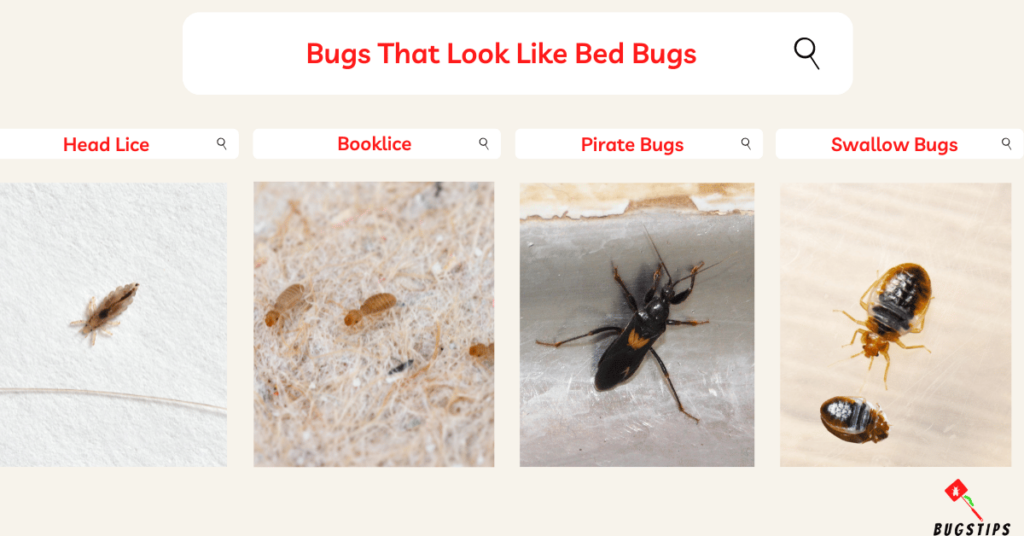
Head Lice
- Head lice are a common nuisance, particularly among school-age children.
- They are greyish-white in color and smaller than bed bugs at 1-2mm long.
- Although they are unrelated to bed bugs, the idea of tiny creatures infesting our personal space can evoke similar concerns.
- Head lice attach their eggs to hair shafts, while bed bugs lay eggs in crevices.
- Bites from head lice are concentrated on the head and neck and lice grasping onto hairs feels like something moving on the scalp.
Booklice
- Booklice, also called psocids, are tiny soft-bodied insects under 2mm long.
- They eat mold and fungi and infest damp books, papers, and household goods.
- Their bodies are pale, light gray to translucent white – similar to bed bug nymphs. but booklice have longer antennae and may have tails or wings.
- Their tiny size helps differentiate them from most bed bugs.
Related Article – 13 Bugs That Look Like Black Sesame Seeds
Pirate Bugs
- Pirate bugs are solid black, oval true bugs that bite humans.
- Since they are black, they look less like bed bugs which are brownish or reddish but at about 1/4 inch long, their size overlaps with bed bugs.
- However, pirate bugs move very quickly when disturbed and they give off a characteristic rotten smell from their scent glands.
- Their legs also have thicker segments than bed bugs.
Swallow Bugs
- Swallow bugs live closely alongside their namesake bird, clinging to cliff swallow nests or migrating with them.
- But when nests are abandoned, swallow bugs seek other sources of blood, biting humans.
- They resemble bed bugs in shape and size but are brownish-black rather than red and lack a flattened profile.
- A key differentiator is their longer mouthparts that protrude forward from the head.
You May Also Like – 16 Green Bugs That Bite
How to Differentiate: Bed Bugs vs. Lookalikes
While the bugs we’ve discussed may appear similar to bed bugs at first glance, there are some key differences that can help discern bed bugs from imposters.
The following table summarizes how to differentiate bed bugs from other insects based on appearance, feeding habits, and other characteristics.
| Bug | Bites & Feeding | Size and Shape | Color |
|---|---|---|---|
| Bed Bugs | Small, red, itchy welts often in a line or cluster. Feed solely on blood of humans and other mammals. | Flat, oval-shaped, wingless, 1/4 inch long | Reddish-brown, apple seed-like nymphs are lighter |
| Bat Bugs | Identical bite marks to bed bugs. Preference for bat blood but will bite humans. | Larger and hairier than bed bugs | Same coloration as bed bugs |
| Ticks | Painless bite, rash or spot at bite site. Feed on blood of mammals, birds, reptiles. | Round body, eight legs. Very small when unfed. | Brown, black, reddish-orange, or tan |
| Fleas | Itchy bites around ankles and feet. Feed on blood of mammals and birds. | Tiny, dark, wingless, oval-shaped | Dark brown or black |
| Mites | Intense itching and rashes. Some feed on humans, others on birds/rodents. | Microscopic, 8 legs, no classic bed bug shape | Translucent until engorged then reddish |
| Baby Cockroaches | Do not bite humans. Scavenge on organic waste. | Oval, wingless, grow to have elongated body | White to pale yellow |
| Spider Beetles | Do not bite humans. Feed on wide range of foods and materials. | Rounder and more convex than bed bugs | Brown |
| Carpet Beetles | Do not bite humans. Feed on fabric, carpets, animal products. | Small, rounded, hairy bodies with scales | Vary from white to black with unique patterns |
| Flour Beetles | Do not bite humans. Feed on flour, cereals, pasta, grains. | 1/8 inch long, reddish-brown, elongated oval | Reddish brown |
| Head Lice | Itchy bites concentrated on head and neck. Feed solely on human blood. | Tiny wingless insects 1-2 mm long | Greyish-white in color |
| Booklice | Do not bite. Eat mold and fungi. | Under 2mm, pale, light gray, may have wings | Light gray to translucent white |
| Pirate Bugs | Painful bite marks. Feed on insects and insect eggs. | 1/4 inch long, flatter than bed bugs | Black coloration |
| Swallow Bugs | Identical bites to bed bugs. Feed on swallow birds. | Same size as bed bugs but with longer mouthparts | Brownish-black |
You May Also Like – Airbnb Bed Bugs: How to Avoid and Report
How to Prevent Bugs That Look Like Bed Bugs
While bed bugs can be difficult to control, many of their lookalikes can be prevented with some simple actions.
Here are tips for keeping other insects that resemble bed bugs from infesting your home.
Bat Bugs
- To avoid bat bugs, inspect the exterior of your home for any openings or cracks that would allow bats access, especially around the roofline and attic.
- Seal up any entry points with caulk, steel wool, or wire mesh.
- This will prevent bats from roosting on or near your home and their bugs from invading your living space.
Ticks
- When spending time in grassy or wooded areas where ticks live, wear light-colored clothing, tuck pants into socks, and use an EPA-registered insect repellent containing DEET.
- Check your body and clothing for ticks and remove any immediately.
- Keep grass mowed and clear away brush and leaf litter from your yard.
Fleas
- Fleas can be kept at bay by using veterinarian-recommended flea control products on your pets year-round.
- Vacuum frequently and wash your pet’s bedding often.
- Consider hiring a professional pest control company to treat your home if fleas persist indoors.
Related Article – 7 Little Black Bugs on Dogs Not Fleas!
Mites
- To control mites, if possible reduce indoor humidity below 50 percent.
- Clean with hot, soapy water and vacuum often to remove dust mites in bedding and carpets.
- Discard infested books and papers and remove bird and rodent nests near your home to eliminate access by those mites.
Baby Cockroaches
- To discourage cockroaches, store food in sealed containers, clean up spills and crumbs right away, take out trash frequently, and fix any water leaks.
- Use roach baits or boric acid powder in likely hiding spots and seal cracks and crevices where they can enter.
Spider Beetles
- Spider beetle infestations often originate in clutter like piles of paper or boxes.
- Reduce clutter and vacuum regularly to remove food sources.
- Inspect pantries for signs of beetles and discard infested products. Use pheromone traps to monitor for beetles.
Related Article – 22 Bugs with Hard Shells
Carpet Beetles
- Vacuum carpets and upholstered furniture frequently to remove carpet beetle larvae and eggs.
- Clean under furniture, in closets, and where pet hair collects.
- Avoid storing clothing or other items in direct contact with carpets or floors.
Flour Beetles
- Discard any infested grains, cereals, pasta, or baking mixes and store unopened food in sealed, hard plastic or glass containers.
- Clean pantries thoroughly and do not let crumbs or spilled flour accumulate.
- Also, make sure to freeze flour and grains for 4-7 days to kill any hidden eggs.
Head Lice
- Inspect children’s heads for lice and nits if they exhibit scratching.
- Treat with medicated shampoo and thoroughly clean clothing, bedding, brushes, and other hair items.
- You can teach kids not to share personal items like hats or hair accessories with others.
Related Article – Bugs in Mailbox: 10 EASY Ways to Keep Them Out
Booklice
- Fix any water leaks, eliminate dampness, and discard infested papers, books, cardboard, and related items.
- Clean bookshelves and storage areas to remove booklice eggs and debris.
Pirate Bugs
- Seal cracks around windows and doors to prevent entry Also use screens on any openings for ventilation.
- Reduce outdoor lighting around your home which attracts the insects they prey on.
- Clear away leaf litter, mulch, and yard debris where bugs may breed.
Swallow Bugs
- Exclude swallow birds from nesting on or near your home by removing existing nests and installing netting, spikes, coils, or slope modification.
- Without their hosts, swallow bugs will not take up residence.
You May Also Like – 15 Tiny Yellow Bugs
Final Thoughts
While bed bugs can be challenging pests to eliminate once established, taking steps to avoid invasion from their lookalikes is much more straightforward.
Now that you know how to identify bed bugs and differentiate them from similar biting or stinging insects, you can inspect questionable culprits more confidently.
If you do find yourself dealing with an infestation of bat bugs, mites, fleas, or other bed bug doppelgangers, use the prevention tips provided to take appropriate control measures.
With proper identification and vigilance, you can keep bed bugs and the bugs that mimic them from becoming unwelcome, long-term guests in your home.
While occasional run-ins with their lookalikes may occur, a watchful eye and swift response will go a long way in keeping your family pest-free.
FAQs
What bugs can be mistaken for a bedbug?
Bat bugs, ticks, fleas, mites, baby cockroaches, spider beetles, carpet beetles, flour beetles, head lice, booklice, pirate bugs, and swallow bugs are some insects that are often confused with bed bugs due to their similar appearance.
Do all bed bug lookalikes bite humans?
Not all bed bug lookalikes bite humans. Some, like fleas and head lice, do bite humans, while others, such as spider beetles and carpet beetles, do not.
What if I find one bed bug but no other signs?
Discovering a single bed bug without other signs doesn’t necessarily indicate an infestation.
Monitor for additional bugs or signs like bites, fecal stains, or molts. If concerns persist, consider a professional inspection.
Resources – (for further reading)
Colorado State University – Bat Bugs, Bed Bugs and Relatives – 5.574
Edinburg Animal Hospital – Fleas, Mites, and Ticks | West Windsor, NJ
Smithsonian Institution – Beetles (Coleoptera)

